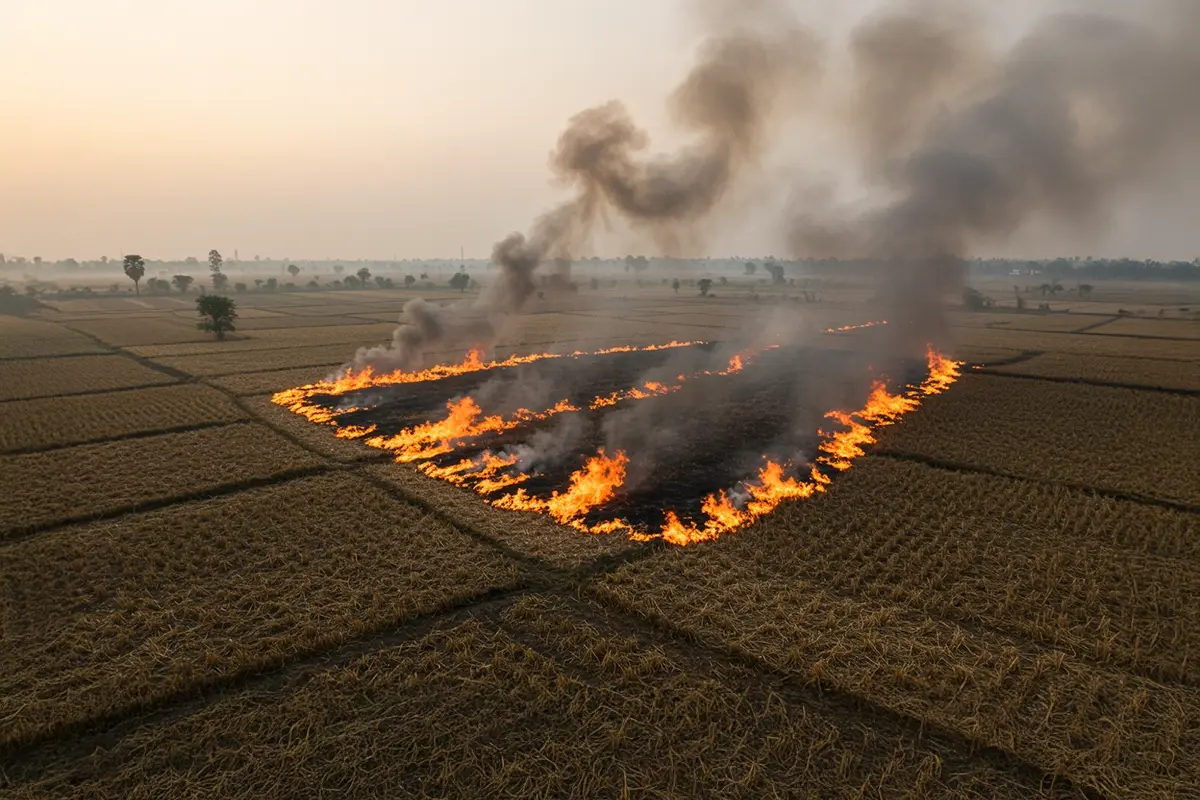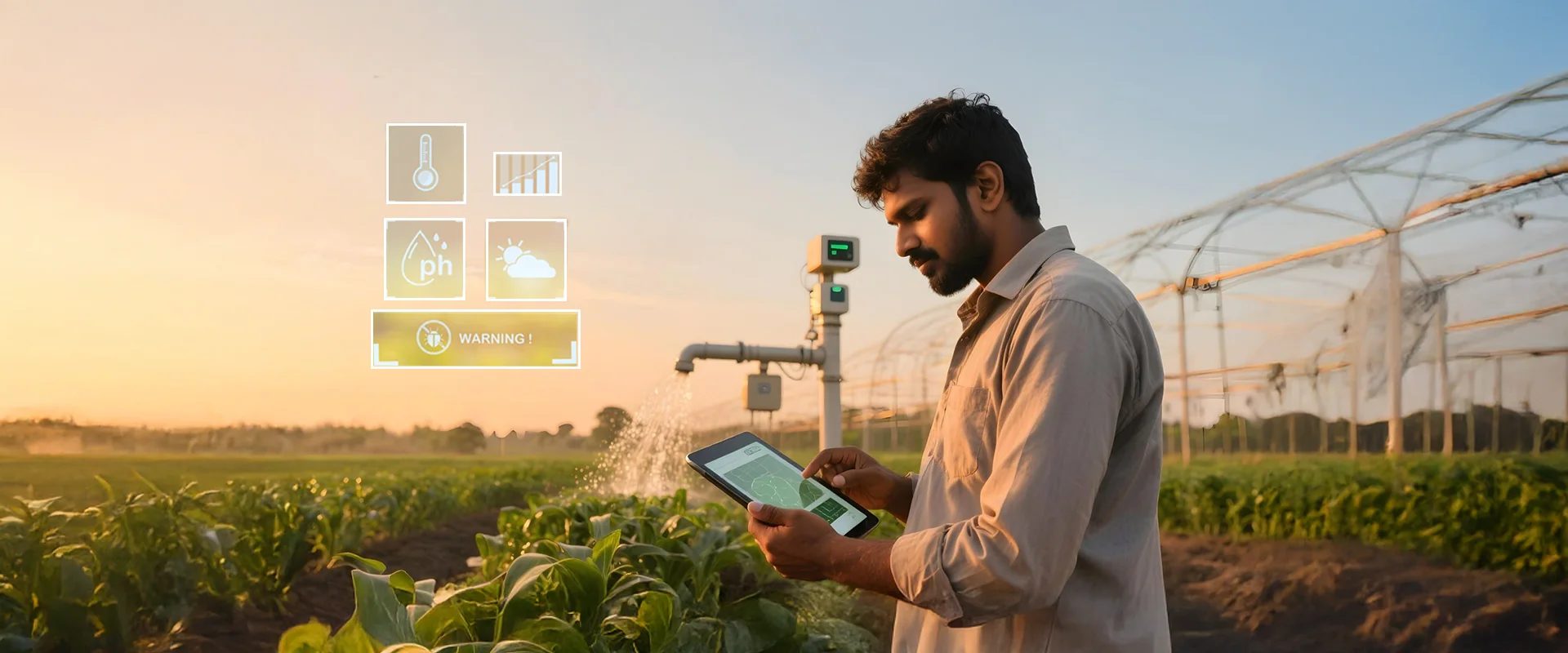The Indian Green Revolution from the late 1960s until the 1970s aimed to strengthen food grain production, especially in the northern states of Punjab, Haryana, and Uttar Pradesh. Farmers soon started adopting modern farming methods, such as high-yielding variety (HYV) seeds, pesticides, fertilizers, tractors, harvester combines, and irrigation facilities.
With agriculture practiced at scale in these regions, farm mechanization proved to be a boon, resulting in a dramatic increase in agricultural productivity and economic development in the decades that followed. The farm mechanization also ensured that farmers could harvest large tracts of land within the short three-week window.
However, one of the foremost drawbacks of mechanized farming that farmers now had to contend with was stubble management.
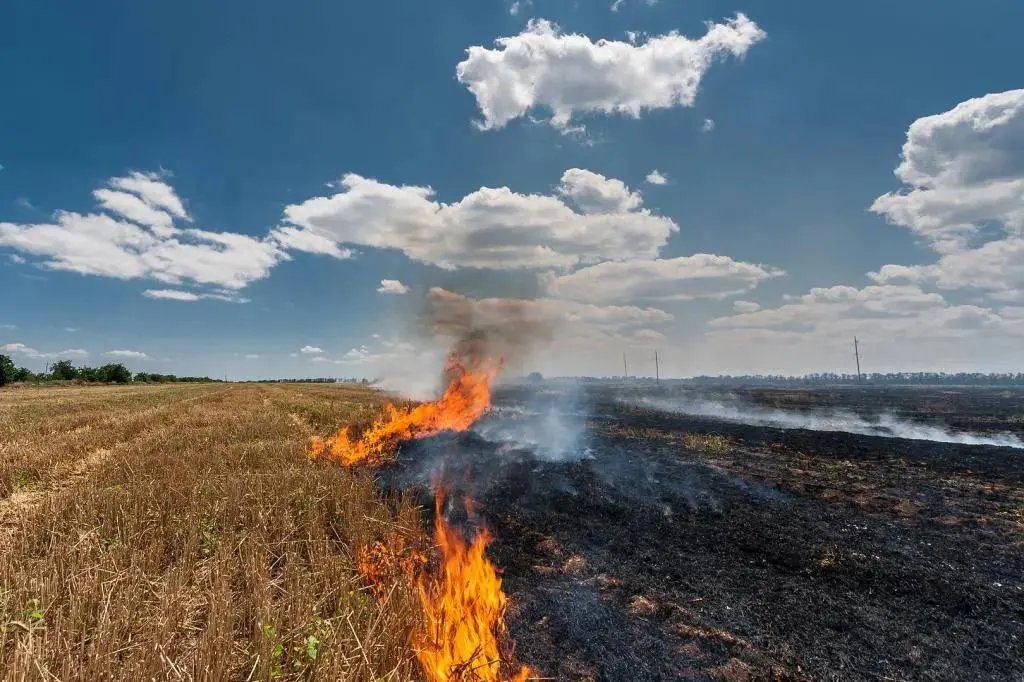
What is stubble burning?
Stubble burning emerged as a cheap, quick, and efficient method to clear away massive volumes of paddy and wheat stubble that mechanized harvesting leaves behind. This residue is up to two feet taller, compared to less than 6 inches after manual harvesting, and takes about one-and-a-half months to decompose.
Besides, state laws in Punjab and Haryana compel farmers to delay nursery sowing and transplantation of paddy by a month, from mid-May to mid-June, to protect the rapidly shrinking groundwater level in the region. The delayed sowing consequently delays harvesting, which leaves farmers with insufficient time to clear the land and prepare the soil bed for the next crop, wheat.
Additionally, residue from paddy (excluding the basmati variety) is unsuitable as animal fodder as it is harder to chew, is high in silica content, and has a low calorific value than other crop residues. Hence, farmers resort to the strategic burning of straw stubbles. It is also effective to remove pests, weeds (particularly herbicide-resistant kinds), and crop diseases from the last crop cycle.
Associated risks of stubble burning
Here are some of the most dangerous consequences of stubble burning:
Pollution
The first and foremost outcome of this technique is that it contributes to air pollution significantly. It not only pollutes the air with harmful gases like carbon monoxide (CO), carbon dioxide (CO2), sulfur oxides (SOx), nitrogen oxides (NOx), methane (CH4), and volatile organic compounds (VOC) but also increases the presence of particulate matters (PM10 and PM2.5) in air. In addition to the existing vehicular and industrial emissions, anywhere between 20% and 70% of Delhi’s haze and air pollution woes arise due to stubble burning in neighboring states during October and November every year. Scientists have also linked pollution to the melting of Himalayan glaciers.
Cropin’s satellite imaging data combined with geospatial technology helps provide detailed crop insights
Talk to us today! Request a Demo
Soil infertility
Stubble burning strips away the essential Nitrogen, Phosphorus, and Potassium (NPK) nutrients and other micronutrients, which affects the soil’s organic quality and long-term productivity. Besides, it considerably reduces the solubility capacity of its upper layers. This burning process leaves behind ashes that deteriorate its nutrient value and dries it as well.
Thermal instability
Burning a tremendous amount of stubble at once results in accelerated heat penetration into the soil, elevating the soil temperature to about 42 °C. Consequently, it leads to the loss of moisture and thermal instability, making it difficult for the succeeding crops to grow. It also kills soil microorganisms present at a depth of 2.5 cm, which are critical for soil fertility.
Carbon losses
Burning stubble also releases about 80% of the carbon component as atmospheric carbon dioxide. Although this carbon release is often only slightly more when compared to the residue’s natural decomposition, it is immediate.
The COVID-19 pandemic has threatened the whole world socially, economically, and, most importantly, health-wise. Considering that respiratory conditions are one of the comorbidities that result in COVID-19-related mortality, deteriorating air quality can make the COVID-19 pandemic deadlier for those areas affected by stubble burning.
Is stubble burning still practiced?
Several countries have regulations in place for stubble burning. While the United Kingdom and China prohibit the practice and the European Union discourages it as a part of the Common Agricultural Policy, some northwestern states in the United States regulate the practice. In Australia, however, though most farmers prefer stubble burning, it is permitted and recommended for certain circumstances.
In the northern Indo-Gangetic Plains of India, despite raising several environmental concerns and state governments placing a ban on and even criminalizing the practice, stubble burning is still practiced at the end of in Kharif and Rabi seasons for various reasons. In tropical countries like India, climate conditions do not favor farmers all the time. To grow crops, especially during winter, farmers get very short intervals to complete the whole process. Sometimes, unforeseen weather conditions, such as rain or extreme cold, hampers the sowing process.
Some crops tend to reduce the fertility of the land. Therefore, it becomes necessary to take the residue out of the soil. Therefore, techniques like stubble burning are practical to eliminate the previous crop residue faster and reduce the nitrogen tie-up.
Best and safest alternatives to stubble burning
Given below are a few alternative practices for stubble burning to prevent pollution and other health hazards. Nevertheless, these alternatives are not yet prevalent. Farmers often incur additional expenses, or the equipment required for these practices are not readily available. Custom hiring centers are also reluctant to purchase the machinery considering it will remain unused for most of the year, except for the 15 days once or twice a year.
In-situ treatment of stubble
In-situ management of crop residues is one of the best ecosystem conservation techniques. It helps get rid of the crop residues, keeping the nutrients of the soil intact.
Happy seeder: It is a tractor-mounted no-till planter for the in-situ management of paddy stubble. It can cut and lift rice straw and sow wheat directly into the soil without prior seedbed preparation. It then deposits the straw residue over the cultivated area as mulch, adding much-needed organic value to the earth. The machine reduces the cost, time, and effort required to do this process manually. Although the state governments provide these machines at a subsidized value, several farmers have reported a shortage of equipment in the past few years.
Pusa bio-decomposer: It is a low-cost microbial bio-enzyme solution that converts crop residue into manure, reportedly in 15-20 days. A day or two after applying the solution, farmers will till and water the fields, which will trigger the accelerated decomposition of the residue.
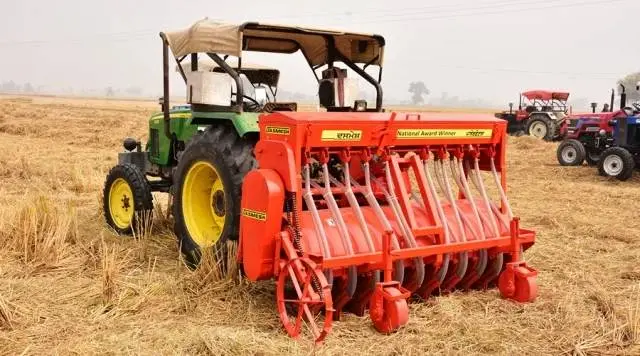
Some of the other agricultural machines that help manage crop residues in-situ are:
- Rotavator, for land preparation and to incorporate crop residue in the soil
- Zero-till seed drill for land preparation and directly sowing seeds in the previous crop’s stubble
- Baler, to collect and compress residue into compact bales
- Paddy straw chopper-cum-spreader, to cut paddy stubble and spread it around the field
- Reaper binder, to harvest paddy stubble and make into bundles
Ex-situ management of crop residues
Ex-situ or “off-site” conservation and treatment of crop residue is also effective. It eliminates the leftover crops from the land from its natural habitat. Plus, this process is much more eco-friendly than stubble burning.
Converting straw to biochar: Biochar is charcoal generated by the pyrolysis of biomass in the absence of oxygen. Biomass includes organic material from agricultural and forestry wastes and is a green, renewable source of carbon. Producing biochar from biomass releases energy with almost no sulfur and insignificant amounts of nitrogen. Crop residues are abundantly available and contain high carbon content. Hence, using them to produce biochar helps with biosequestration in a stable form every year and, consequently, lessen the adverse effects on the environment. Biochar is also notable for its potential value to improve soil quality.
Alternate use for paddy stubble: Other innovative yet commercial applications for crop residue include re-using it to make products such as paper and packing materials, treating it as an alternate fuel source to generate energy in cement, sugar or oil factories, and converting it to a pulp for the manufacture of sustainable tableware.
2G Ethanol from agro-waste: There is a growing demand for renewable fuels to replace fossil-based ones. Notably, grain crops store only half of the energy they capture in the harvestable grain, which offers significant potential to extract energy from the crop residues. Manufacturing second-generation (2G) bio-ethanol from lignocellulosic biomass will support the twin objective of preventing stubble burning and replacing fossil fuels with a cleaner, renewable alternative.
Changing crop pattern
Apart from in-situ and ex-situ treatments, an effective alternative for this process is changing the crop cultivation pattern. Fruits, vegetables, or other low-residue crops that are not water-intensive, too, are excellent substitutes for wheat and paddy.
Genetically modified crop varieties are also beneficial to farmers. For instance, shorter-duration paddy varieties, like Pusa Basmati-1509 and PR-126, have a seed-to-seed maturity of about 120–125 days. They allow farmers to harvest during the third week of September itself, thus widening the window until the start of the wheat season. The primary disadvantage of producing basmati, vegetables, fruits, pulses, or other crops is that the government does not list these under the MSP-based procurement system. It hence deprives farmers of an assured income.
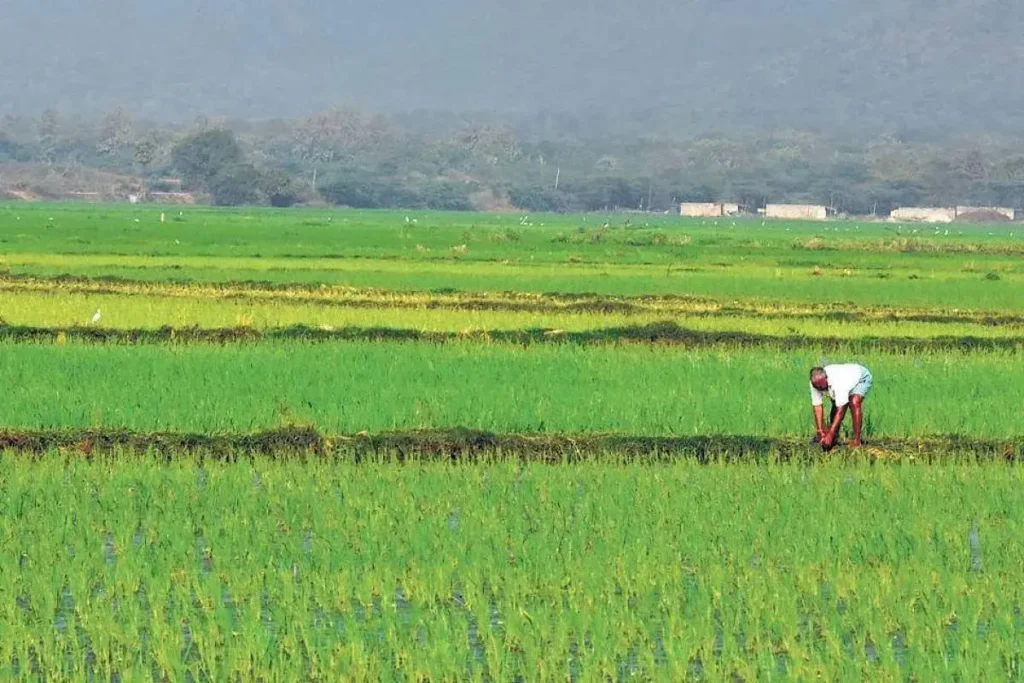
Assessing the environmental impact of stubble burning & risk mitigation using remote sensing
Significant progress in remote sensing applications provides a large-scale solution to map and monitor rice and wheat growing areas and stubble burning patterns in the region. Cropin is pursuing extensive research to employ remote-sensing-based solutions for risk mitigation associated with crop residue burning and generate statistics that government bodies could utilize to streamline policies. The initiative also aims at delivering data-backed insights that emerging businesses could benefit from in their process of mobilizing the crop stubble, thereby reducing the risk of environmental damage.
Cropin’s geospatial AI/ML framework consumes near-real-time satellite imagery and generates various remote sensing indices from multi-spectral bands across visual to thermal to examine the environmental impact of crop residue burning. ML models help analyze the Rice-Wheat system (RWS) that farmers follow across the 630-million-acre stretch of the Indo-Gangetic Plain. This data will act as a reference to monitor the crop residue burning activity on fields.
SmartRisk’s remote-sensing-based crop detection will highlight the crop sowing patterns and crop stages of the RWS for the different villages. The VIIRS (Visible Infrared Imaging Radiometer Suite) data from NASA provides active fire mapping complemented by various other remote sensing indices, such as the burning area index (BAI) and Normalized burning ratio (NBR), derived from thermal and shortwave infrared bands. Together, they expedite the identification of stubble burning, both current and historical. The historical information, when integrated with sowing patterns, crop stages, and weather seasonality parameters takes a tailored precision agriculture approach to contribute to designing the likelihood model that forecasts the stubble-burning areas.
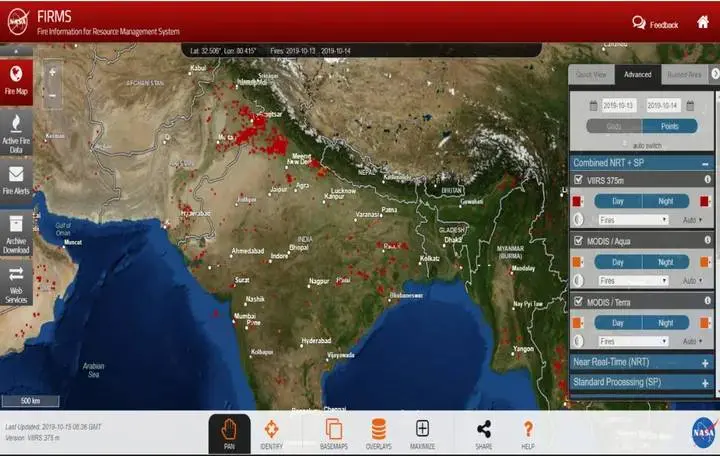
Further, satellite-based monitoring of poisonous gases and particles in the atmosphere (carbon monoxide, nitrogen dioxide, and particulate matter) enables us to derive a pollution index for the region.
In summation, Cropin’s platform monitors near-real-time remote-sensing data and analyses statistics at different levels of administrative boundaries to enable intelligent, data-driven decision-making. It would empower the concerned entities to undertake sustainable mitigation measures while supporting farmers to boost their revenue and preserve their agricultural productivity and land fertility, too.
There are several possible outcomes of this endeavor.
- Entities can tag villages based on the likelihood and intensity of their contribution to pollution and plan appropriate action for risk mitigation on priority.
- Governments can implement awareness programs for policies, subsidies, and other measures to reduce crop residue burning. They can also support the establishment of projects and self-help groups (SHGs) that procure the crop stubble for alternate use.
- Private enterprises and petroleum companies involved in 2G bio-ethanol production can use these insights to identify rice and wheat growing areas weeks in advance and plan for the procurement of crop stubble efficiently.
- Likewise, enterprises procuring crop stubble for other uses, as mentioned above, can use Cropin’s platform to monitor crop stage and connect with farmers directly during the harvest period.
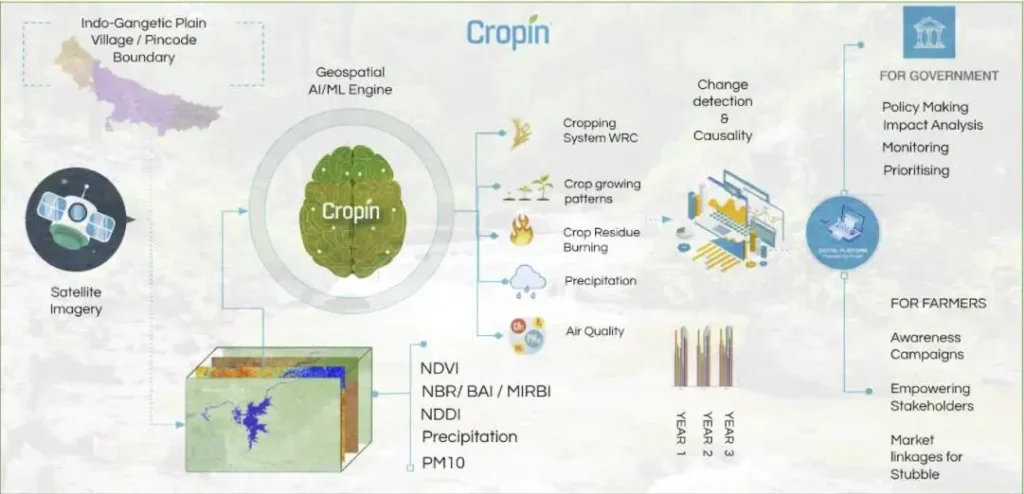
Cropin Intelligence Platform for Crop Residue Burning Impact Assessment
With rapid industrialization and urbanization, global warming and climate change have already become critically concerning issues. In such a situation, stubble burning is a dangerous practice that can take a huge toll on the entire ecosystem. Therefore, it is certainly time to call for a complete ban on such burning practices and choose greener alternatives.

